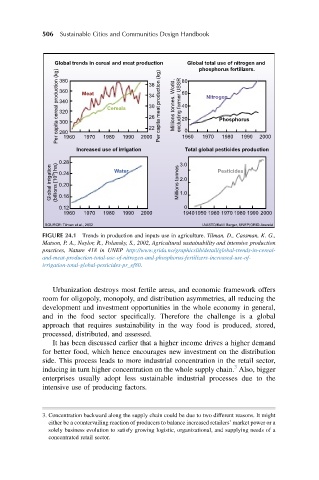Page 537 - Sustainable Cities and Communities Design Handbook
P. 537
506 Sustainable Cities and Communities Design Handbook
Global trends in cereal and meat production 80 Global total use of nitrogen and
phosphorus fertilizers.
Per capita cereal production (kg) 360 Meat Cereals 38 Per capita meat production (kg) Millions tonnes. World, excluding former USSR 60 Nitrogen
380
34
340
40
30
320
26
20
Phosphorus
300
22
0
280
1960
1970
1990
1980
Increased use of irrigation 2000 1960 1970 1980 1990 2000
Total global pesticides production
0.28 Water 3.0 Pesticides
Global irrigation (billions [10 9 ] ha) 0.24 Millions tonnes 2.0
0.20
1.0
0.16
0.12 0
1960 1970 1980 1990 2000 19401950 1960 1970 1980 1990 2000
SOURCE: Tilman et al., 2002 IAASTD/Ketill Berger, UNEP/GRID-Arendal
FIGURE 24.1 Trends in production and inputs use in agriculture. Tilman, D., Cassman, K. G.,
Matson, P. A., Naylor, R., Polansky, S., 2002, Agricultural sustainability and intensive production
practices, Nature 418 in UNEP http://www.grida.no/graphicslib/detail/global-trends-in-cereal-
and-meat-production-total-use-of-nitrogen-and-phosphorus-fertilizers-increased-use-of-
irrigation-total-global-pesticides-pr_ef80.
Urbanization destroys most fertile areas, and economic framework offers
room for oligopoly, monopoly, and distribution asymmetries, all reducing the
development and investment opportunities in the whole economy in general,
and in the food sector specifically. Therefore the challenge is a global
approach that requires sustainability in the way food is produced, stored,
processed, distributed, and assessed.
It has been discussed earlier that a higher income drives a higher demand
for better food, which hence encourages new investment on the distribution
side. This process leads to more industrial concentration in the retail sector,
3
inducing in turn higher concentration on the whole supply chain. Also, bigger
enterprises usually adopt less sustainable industrial processes due to the
intensive use of producing factors.
3. Concentration backward along the supply chain could be due to two different reasons. It might
either be a countervailing reaction of producers to balance increased retailers’ market power or a
solely business evolution to satisfy growing logistic, organizational, and supplying needs of a
concentrated retail sector.

